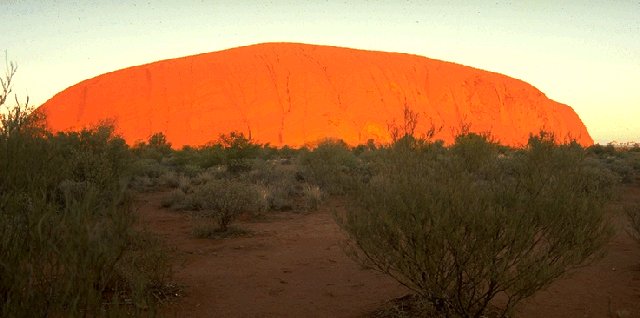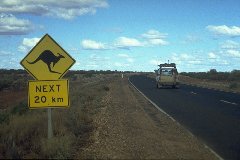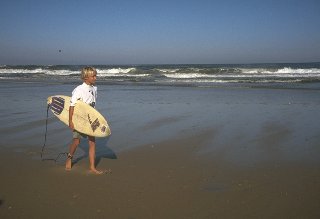
ABeR - Alternativ Bus Reisen GmbH
Behringstr. 42 - 44 * 22763 Hamburg * Phone
+ 49 - 40 - 393 * Fax + 49 - 40 - 39
00 589
Hamburg
* Berlin
* Hannover
* Bremen
* Dresden
* Munich
Cross-Country
incl. Flights
Australia
Deutsche Version: Australien

Sydney, Great Barrier Reef, Desert, Kulture of the Aborigines
By bus along breathtaking landscapes abound in the immense expanse
of this "largest island in the world." The climatic range from south to
north corresponds to the distance between the North Pole and Africa.
Itinerary: Flight Frankfurt - Sydney and from Sydney further
to Alice Springs. By bus from Alice springs via Ayers Rock - Tennant Creek
- Mt. Isa - Townsville Cains - Port Douglas - Whitsunday Islands - Brisbane
- Byron Bay - Sydney. Flight Sydney - Frankfurt.
Accommodations: Two nights on plane, three nights at hotel in
Sydney, two nights at camping site in Ayers Rock, one night at camping
site in Alice Springs, one night at camping site in Tennant Creek, one
night at camping site in Mount Isa, one night at camping site in Normanton,
eight nights at youth hostel and at camping site in Port Douglas, one night
at camping site in Airlie beach, two nights at camping site in Whitsunday,
one night at camping site in Tannumsand, two nights at camping site in
Byron Bay, two nights at hotel in Sydney, one night on plane.
Meals: For your meals you should expect to spend approx. $12
per day
Tour Escort: Tour coordinator
Extra: At campgrounds, you can rent cottages or trailers for
$5 Australian per person. In Port Douglas, you can take scuba lessons for
$250 Australian. Lessons, equipment and boat rental, and four dives off
the Great Barrier Reef are included. If you pass the final written exam,
you get your diving certificate! Please state your preferences when booking.
Climate: Sydney: average temperature 50 degrees Fahrenheit
Alice Springs: 50-90 degrees Fahrenheit
Port Douglas: 70-90 degrees Fahrenheit
Currency: US $1 = Australian $1.14
Visa: A tourist visa is required for Australia
Tour-Guide: More information by the Australian
Tourist Commission. This site has won the Web Award of the ENTER '97
for the best web site of tourist regions.
To the tour dates
Come to the Land Down Under
Contrary to widely held beliefs, kangaroos do not go shopping in
Sidney on Friday afternoons. While there are many of these strange marsupials
around (over 50 different species, to be precise), Australia offers far
more than that.
 Breathtaking
landscapes - above ground and underwater - abound in the immense expanse
of this "largest island in the world." The climatic range from south to
north corresponds to the distance between the North Pole and Africa. Instead
of going from Lisbon to Moscow, one could cross Australia from east to
west, but only theoretically because there is - with the exception of a
few dangerous desert back roads - no highway that runs all the way through
the country. Even if there were, you would still have to drive more or
less around the edges of the country.
Breathtaking
landscapes - above ground and underwater - abound in the immense expanse
of this "largest island in the world." The climatic range from south to
north corresponds to the distance between the North Pole and Africa. Instead
of going from Lisbon to Moscow, one could cross Australia from east to
west, but only theoretically because there is - with the exception of a
few dangerous desert back roads - no highway that runs all the way through
the country. Even if there were, you would still have to drive more or
less around the edges of the country.
We will limit ourselves to the eastern half of the country, since there
we find everything that Australia is famous for - at least among insiders.
Here we find the last traces of the 40,000 year history of the original
inhabitants of Australia; the Aborigines, whose numbers, in only 200 years
of English "settlement," reduced to a minimum. In the middle of the great
continent, in the red center, beats the stone heart of the Aborigines,
the sacred mountain Uluru, better known by its English name Ayers Rock.
In the tropical north we can follow the tracks of a certain Crocodile
Dundee and, on a guided scuba diving tour, personally explore the Great
Barrier Reef just off the coast, indisputably the most beautiful diving
grounds in the world.
One of the truly great advantages of the Australian north is undoubtedly
the fact that you can enjoy the tropics there without the threat of malaria
or hepatitis and therefore be spared the detrimental effects of immunizations.
White, sandy beaches and countless rocky bays line the over 3,000 miles
of crystal-clear waters on the Pacific east coast.
Only the 15 million "Aussies" remain to be mentioned, the white descendants
of the first settlers or the many later immigrants. They presently attempt
to make partial amends for the crimes committed by the English motherland
(with all due respect to its present-day residents) against the Aborigines.
The friendliness and carefree attitude of the Aussies, whose favorite greeting
is "hey mate," is downright astounding. Along with cricket, beer drinking
is practically a national sport. Moreover, this latter pursuit appears
to offer the only opportunity to experience an unfriendly Aussie - namely,
the one whose offer of a beer you just turned down.
In August, the month of our trip, it is winter here in Australia. That
means ideal travel conditions. The climate in the center of the country
is tolerable and the tropics in the North offer ideal temperature and humidity
for Americans. The water on the reef affords the greatest depth of visibility
between July and October. And the weather in Sydney makes exploration of
this beautiful city a joy. Our partner for this cross-country adventure
is the Australian bus company "Camping Connection," which will provide
us with a comfortable bus as well as a suitably experienced driver for
the journey, as we have nearly 3,600 miles to cover.
After already having viewed Australia from the air, we will make first
contact with the fifth continent in Sydney. Claims that Sydney is
the most beautifully situated big city in the world are certainly not exaggerated.
What other city has so many beaches and parks? With its 3.5 million residents,
Sydney is the largest and most modern city in Australia. This was also
the site of the first white settlement by the English. It is therefore
hardly surprising that everything revolves around the massive harbor. Certainly
everybody has seen the pictures of the enormous Harbour Bridge and the
world famous opera right on the water.
The city forms a small peninsula, enclosed by the harbor on one side
and by an arm of the sea on the other. Sydney has widely varying cityscapes
- from old, restored warehouses to the ultra modern skyline with a high
observation tower in the middle - that make wandering around on foot enjoyable.
Three days should suffice for us to become oriented and familiar with our
surroundings. Then we will make a great, kangaroo-like leap to the oasis
of the Australian Outback, Alice Springs.
By Outback, the Aussies mean everything that lies west of the Great
Dividing Range. Since this mountain range runs the length of and relatively
close to the east coast, the Outback is very large, to say the least.
In Alice Springs we will finally board our bus. The first leg of our
3,600-mile tour is Ayers Rock, Australia's famous landmark. The
world's largest monolith looms up 1,140 feet out of the red desert. Uluru,
which in the language of the Aborigines means "the Shadowcaster," invites
us to climb up to the top of its flat summit to enjoy a spectacular panorama
across the endless desert and savannas of the Outback. In the distance,
the red silhouette of the Olgas, an impressive cluster of giant sand dunes,
contrasts with the blue sky.
First, we will explore the immediate vicinity of the Rock. Besides admiring
the spectacular sunset, which causes the monolith to radiate a glowing
red, we can also take short hikes around the Rock area. As we continue
our tour, we visit Simpson Gap National Park, where Australia's
most beautiful canyons are found. Then we will cross the red desert in
a northerly direction on the Stuart Highway, the only north/south axis,
to Tennant Creek. Here we will change course and head east on the
Barkley Highway to get to our next stopover, Mt. Isa. This mining
city will be a welcome sight in the arid Outback. Once again we change
direction and head north through the tropical wilderness, almost to the
Gulf of Carpentaria, to Normanton.
A day's journey still separates us from the fresh ocean air of the Pacific,
but first we have to get over the crests of the Great Dividing Range.
We draw near to the Atherton Tableland between broad sugar cane
fields and the blue Pacific. The highway winds alongside the tropical forest
and runs north of Cairns directly between jungle and beach to Port Douglas,
a few miles before the "End of Bitumen," the absolute end of the paved
road.
This tropical rain forest north of Cairns has remained almost undisturbed
for 13 million years and is one of the oldest rain forests on earth. Short
hikes in this region and a dip in the swift running waters of Mossman
Canyon - one of the few crocodile-free spots - are enough to raise
a few goose bumps. When you glide in a flat-bottomed boat through the "green
hell" of the tangled mangrove trees, favorite hangout of the dangerous
saltwater crocodile, you are reminded of scenes from "Crocodile Dundee,"
and with a little luck you will see a "croc" dosing in the sun on a sandbank.
Another very beautiful side trip from our base of operations takes us
to the heights of the Atherton Tableland, to Kurunda, which reputedly
has the most beautiful train station in the world. The historical railway
first winds along the edge of a deep canyon, past many waterfalls, and
then runs between rain forest and canyon down to Cairns.
 We
have chosen Port Douglas as our main destination not without reason
- here is surely the world's most stunning diving area, the Great Barrier
Reef. This reef runs for hundreds of miles along the east coast, from
Cooktown to Maryborough, and lies closest to the coast in the north off
Port Douglas, "only" about 24 miles off the continent. Moreover, the water
in the north is the warmest and clearest and the diving school has state-of-the-art
equipment. The diving course lasts one week. For three days, we spend mornings
on the school bench and afternoons in the swimming pool.
We
have chosen Port Douglas as our main destination not without reason
- here is surely the world's most stunning diving area, the Great Barrier
Reef. This reef runs for hundreds of miles along the east coast, from
Cooktown to Maryborough, and lies closest to the coast in the north off
Port Douglas, "only" about 24 miles off the continent. Moreover, the water
in the north is the warmest and clearest and the diving school has state-of-the-art
equipment. The diving course lasts one week. For three days, we spend mornings
on the school bench and afternoons in the swimming pool.
Then, on the fourth and fifth days, we get intense. We jump into the
blue waters with our diving gear for the first time. It is simply unbelievable!
An entirely new world unfolds before our eyes. In this shimmering, magnificently
colorful underwater landscape with its many multicolored fish, we forget
our initial apprehensions about going scuba diving. As we glide through
this new world, we will have our hands full keeping our mouth from gaping
wide open from sheer astonishment, or from laughing out loud when strange-looking,
curious fish come right up to the diving mask to ogle us and then nibble
on our outstretched finger.
After successful completing the course, we receive an international
diving certificate for diving with equipment in open waters (Open Water
License). The non-divers get their money's worth too, because Four-Mile
Beach (in reality, it stretches 40 miles to Cairns) is a white, picture
postcard beach hemmed in by shady palms, ideal swimming, and snorkeling.
Port Douglas is itself an ideal place for us. Everything is still very
quaint and unspoiled and most of the small buildings are literally surrounded
by palms and various other tropical trees. There are two pizzerias, a camera
shop, butchers, etc. on Main Street, and, above all, two old pubs with
beer gardens so that we can partake in the above-mentioned favorite pastime
of the Aussies. Now that we have frolicked around so thoroughly so close
to the equator, it is unfortunately time for the trip back. We will ride
from one swimming stop to the next, always following the coast in a southerly
direction, as long as the water remains the proper temperature for swimming.
Airlie Beach entices us as our next destination, with Australia's
most beautiful island group, the Whitsunday Islands, stretched out along
the coast.
We are better off driving through Australia's Miami Beach, the Gold
Coast and surfer's paradise, without stopping, in order to pitch our tents
again in Byron Bay. Here in Byron Bay, globetrotters from all over
the world meet to dive, surf and socialize in pubs and cafes. The last
leg again presents us with marvelous landscapes that, when we observe them,
look as though they were pieces of a wrongly-put-together jigsaw puzzle
of different regions of the earth. The smooth mountains of the Great
Dividing Range take us down to the coast and, while the roads in the
higher elevations still run through the thickest rain forest, you find
yourself suddenly surrounded by banana trees at lower elevations. Farther
south along the coast, you would feel as though you were in Switzerland,
with black and white Holstein cows and lots of horses in green meadows,
if not for the blue Pacific on your left and the white beaches alternating
with steep, rocky cliffs.
As we again near the big city on the Pacific Highway and the Sydney
skyline appears over the Harbour Bridge and the bustle of traffic
increases, then we will suddenly think of our crowded urban America again
and bid a sad farewell to Australia's endless expanse and its widely varied
flora. In Sydney, we will have the opportunity to obtain some parting souvenirs,
boomerangs, etc. With a little luck, we will see the red heart of Ayers
Rock once more, from above on our flight back to the "civilized" world.
To the tour dates
Back to the tour site
Back to ABeR - home-page
 Breathtaking
landscapes - above ground and underwater - abound in the immense expanse
of this "largest island in the world." The climatic range from south to
north corresponds to the distance between the North Pole and Africa. Instead
of going from Lisbon to Moscow, one could cross Australia from east to
west, but only theoretically because there is - with the exception of a
few dangerous desert back roads - no highway that runs all the way through
the country. Even if there were, you would still have to drive more or
less around the edges of the country.
Breathtaking
landscapes - above ground and underwater - abound in the immense expanse
of this "largest island in the world." The climatic range from south to
north corresponds to the distance between the North Pole and Africa. Instead
of going from Lisbon to Moscow, one could cross Australia from east to
west, but only theoretically because there is - with the exception of a
few dangerous desert back roads - no highway that runs all the way through
the country. Even if there were, you would still have to drive more or
less around the edges of the country.


 We
have chosen Port Douglas as our main destination not without reason
- here is surely the world's most stunning diving area, the Great Barrier
Reef. This reef runs for hundreds of miles along the east coast, from
Cooktown to Maryborough, and lies closest to the coast in the north off
Port Douglas, "only" about 24 miles off the continent. Moreover, the water
in the north is the warmest and clearest and the diving school has state-of-the-art
equipment. The diving course lasts one week. For three days, we spend mornings
on the school bench and afternoons in the swimming pool.
We
have chosen Port Douglas as our main destination not without reason
- here is surely the world's most stunning diving area, the Great Barrier
Reef. This reef runs for hundreds of miles along the east coast, from
Cooktown to Maryborough, and lies closest to the coast in the north off
Port Douglas, "only" about 24 miles off the continent. Moreover, the water
in the north is the warmest and clearest and the diving school has state-of-the-art
equipment. The diving course lasts one week. For three days, we spend mornings
on the school bench and afternoons in the swimming pool.